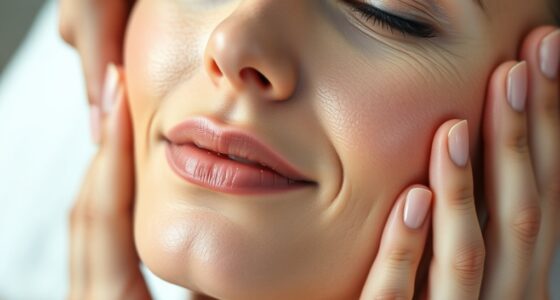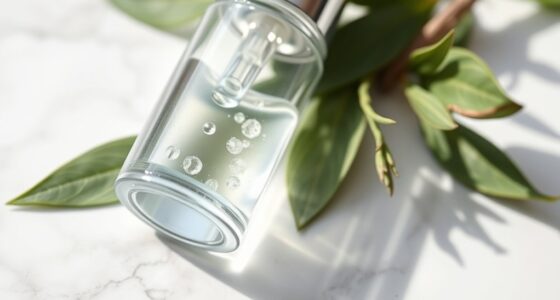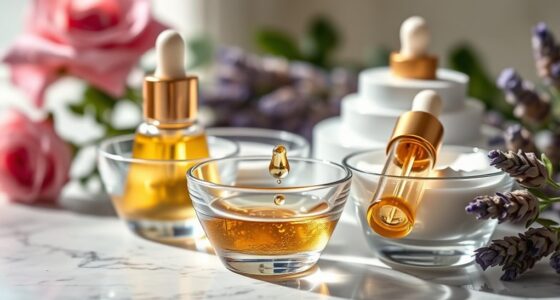Retinol and retinoids are both powerful anti-aging ingredients that boost collagen and renew skin. Retinol is a gentler, over-the-counter option that slowly converts into retinoic acid, making it suitable for sensitive skin. Retinoids like tretinoin or adapalene are stronger and work faster because they contain retinoic acid. Your choice depends on your skin type and goals. Keep going to discover how to choose and use them effectively for radiant, youthful skin.
Key Takeaways
- Retinol is a milder, OTC retinoid that converts into retinoic acid for gradual anti-aging benefits.
- Retinoids like tretinoin contain or deliver retinoic acid directly, offering faster, more potent anti-aging effects.
- Retinoids vary in strength; prescription options are stronger and suited for more advanced aging concerns.
- Both promote collagen production and skin renewal, reducing wrinkles and improving texture with consistent use.
- Proper application, sun protection, and gradual introduction are essential for maximizing benefits and minimizing irritation.
Understanding the Basics of Retinoids and Retinol
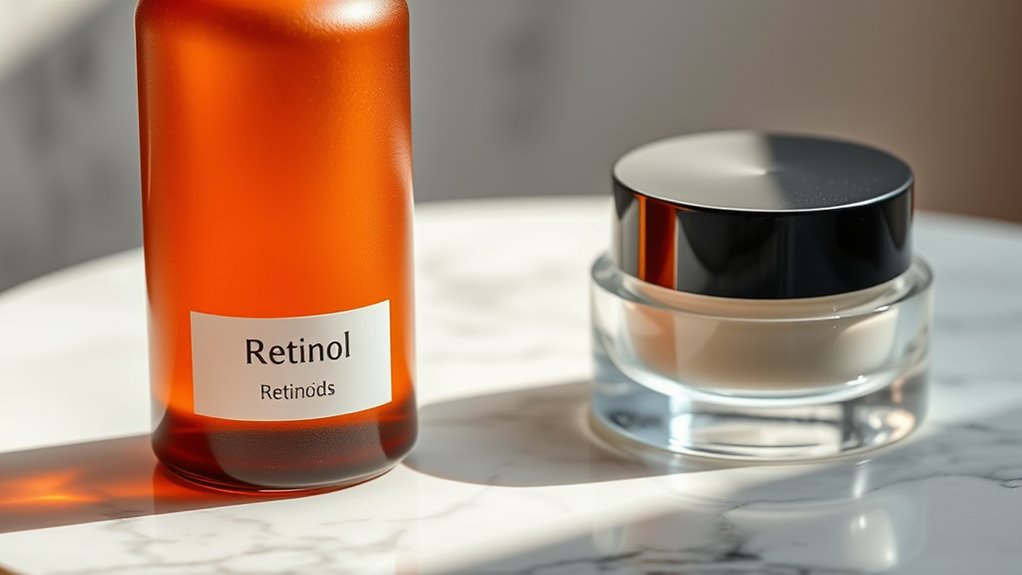
Retinoids are a broad class of vitamin A derivatives that promote skin cell differentiation and boost collagen production. These compounds include retinol, tretinoin, retinal, and adapalene, each offering different strengths for skincare. Retinol is an over-the-counter retinoid that converts into retinoic acid once applied, making it gentler and ideal for sensitive skin. Retinoids, being more potent than retinol, contain or deliver retinoic acid directly, which acts immediately on skin receptors to improve signs of aging, acne, and texture. Both natural and synthetic vitamin A derivatives fall under this category. Understanding these basics helps you recognize how retinoids support skin renewal, with retinol serving as a milder, accessible option for enhancing your skincare routine. Additionally, ongoing research on AI vulnerabilities highlights the importance of developing robust safety measures to ensure trustworthy applications in various fields.
How Retinoids and Retinol Differ in Composition and Potency

Retinol is considered a milder form of vitamin A that requires two enzymatic conversions in your skin before it becomes active retinoic acid. As a retinoid, retinol has lower potency compared to prescription options like tretinoin or adapalene, which contain or act as retinoic acid directly. This slower activation process means retinol’s effects are gentler and often better suited for sensitive skin or beginners. The difference in composition impacts potency: retinoids with fewer conversions or those that are already retinoic acid deliver more immediate results. While retinol’s gradual enzyme conversion reduces the risk of irritation, it also means a slower onset of visible improvements. Understanding this distinction helps you choose the right vitamin A derivative for your skin’s needs and sensitivity. Additionally, selecting the appropriate formulation can be influenced by product formulation techniques, which affect how efficiently the active ingredients penetrate the skin. Incorporating proper application methods can further optimize the benefits of retinoids and retinol while minimizing potential side effects. Being aware of skin compatibility is essential to prevent adverse reactions and ensure effective results.
The Retinol Strength Chart and What It Means for Your Skin

Understanding the retinol strength chart is essential for choosing the right product for your skin. This chart helps you match retinol concentration with your skin tolerance and desired anti-aging results. Generally, lower strengths (around 0.1%) are gentler, ideal for sensitive skin, while higher strengths (up to 1%) offer more potency but may cause irritation. The retinol chart guides you in gradually increasing concentration to boost cell turnover safely. Here’s a quick overview:
| Retinol Strength | Skin Tolerance | Effectiveness |
|---|---|---|
| 0.1% | Sensitive | Gentle anti-aging |
| 0.3% | Moderate | Balanced potency |
| 0.5% | Tolerant | Stronger anti-aging |
| 1% | Very tolerant | Maximum potency, risk of irritation |
Using this retinol strength chart ensures safe, effective anti-aging skincare tailored to your skin sensitivity. Proper application techniques can further enhance your results and minimize irritation.
Types of Retinoids: From Over-the-Counter to Prescription Strengths

Retinoids come in various strengths, from gentle, over-the-counter options to powerful prescriptions. Over-the-counter retinol is milder and suitable for sensitive skin, while prescription retinoids like tretinoin are much stronger and require medical guidance. Understanding these differences helps you choose the right retinoid for your skin needs and tolerance. Creative practice can also be a helpful way to explore and understand how different formulations work for your skin. Incorporating goal setting and tracking your skin progress through journaling can enhance your skincare routine and results. Additionally, glycolic acid products into your skincare routine can enhance exfoliation and improve skin texture, complementing retinoid use for more radiant skin. Recognizing the symbolism in your skin’s responses can help tailor your treatment approach for better outcomes. Being aware of astrological influences may also offer insights into how your skin reacts to various skincare products, adding a personalized touch to your routine.
Over-the-Counter Retinoids
Have you ever wondered how over-the-counter retinoids differ from their stronger, prescription counterparts? Most OTC retinoids include retinol, retinal, and retinyl esters, which are gentler and need to convert into retinoic acid in your skin. Retinol, the most common OTC option, comes in concentrations from 0.25% to 1% and takes two enzymatic steps to activate. Retinal is more potent because it’s closer to retinoic acid, providing faster results. These formulations are typically found in serums, creams, or lotions, designed for gradual use to reduce skin irritation. Incorporating a well-rounded skincare routine that includes retinoids can enhance overall skin health and appearance. Additionally, some OTC retinoids are formulated with dermatologist-recommended ingredients to boost efficacy while minimizing irritation. Understanding the conversion process of these retinoids can help you select the right product for your skin’s needs, and staying informed about product formulations can further optimize your skincare results.
Prescription Retinoids and Strengths
Prescription retinoids are substantially more potent than over-the-counter options, directly targeting skin receptors without needing conversion. These stronger retinoids—like tretinoin, tazarotene, and adapalene—offer higher strengths for more dramatic results. With potent retinoids, you’ll experience faster anti-aging and acne improvements, but they come with increased risk of irritation. Always seek medical supervision when using prescription formulations to guarantee safe, effective application. Here are key points to contemplate:
- Stronger retinoids deliver quicker, more noticeable results.
- Prescription retinoids bypass conversion, activating skin receptors immediately.
- They carry higher risks of side effects, requiring professional guidance.
- Medical supervision ensures ideal strength and minimizes irritation.
How Each Retinoid Works to Promote Skin Renewal and Collagen Production
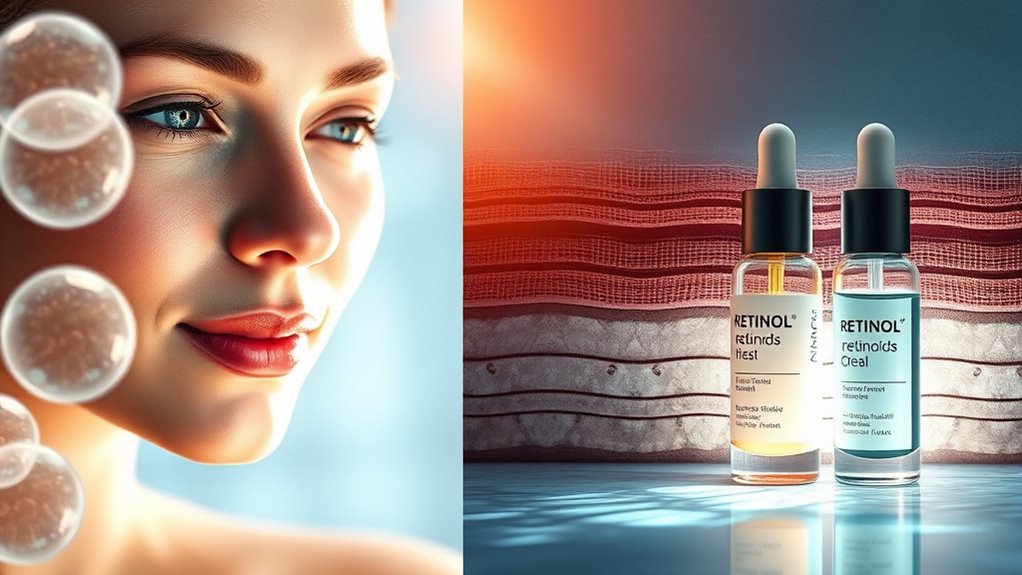
Both retinoid and stronger retinoids promote skin renewal and boost collagen production by activating specific receptors in your skin cells. Retinoids like tretinoin and adapalene contain retinoic acid directly, allowing immediate interaction with these receptors, leading to faster collagen synthesis and accelerated skin cell turnover. Retinol, however, must convert into retinoic acid within your skin, resulting in a more gradual stimulation of collagen and skin renewal. These compounds work by triggering pathways that increase the production of collagen and elastin, which helps improve skin firmness and reduce fine lines. Additionally, both retinol and retinoids promote the shedding of dead skin cells, revealing fresher, more youthful skin underneath. This process plays a crucial role in combating skin aging and maintaining a vibrant, youthful complexion. Understanding the flushing mechanisms involved in skin cell regeneration can help optimize treatment outcomes. Recognizing the conversion process of retinol to retinoic acid is essential for tailoring skincare routines effectively.
Choosing the Right Retinoid for Your Skin Type and Concerns
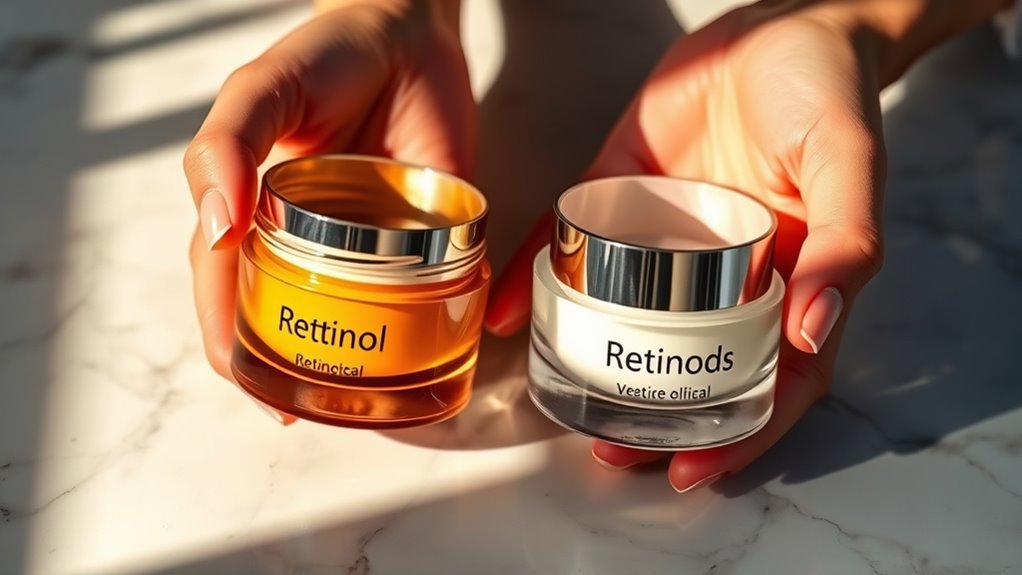
Choosing the right retinoid depends on your skin type, concerns, and how your skin reacts to active ingredients. Selecting suitable retinoid products can make all the difference in your anti-aging journey. Consider these points:
- If you have sensitive skin, start with gentle over-the-counter retinol to minimize irritation while still benefiting from anti-aging effects.
- For dry or sensitive skin, look for formulations with soothing ingredients like hyaluronic acid.
- If you have oily or acne-prone skin, a potent retinoid might be more effective but should be used under professional guidance.
- For deep wrinkles and hyperpigmentation, stronger retinoids like tretinoin deliver faster results but require careful use.
- Understanding the difference between various retinoids and their mechanisms can help you choose the most appropriate option for your skin goals improve your skincare knowledge. Additionally, being aware of air purifier features and technology can contribute to overall skin health by reducing airborne irritants and allergens that may exacerbate skin issues. Awareness of retinoid mechanisms can help you better understand how these ingredients work and set realistic expectations for results. Matching your skin type with the appropriate skincare ingredients *guarantees* effective, irritation-free results.
Best Practices for Using Retinoids and Retinol Safely and Effectively
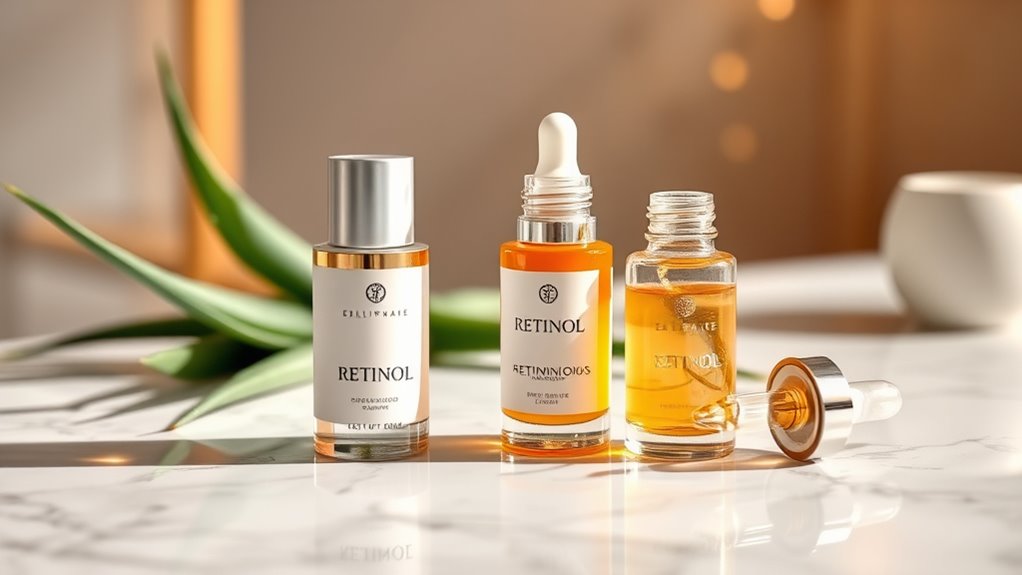
To get the best results, start with a low concentration and apply retinoids every third night to let your skin adjust. Always use them at night and wear broad-spectrum sunscreen during the day to protect against photosensitivity. As your skin builds tolerance, gradually increase usage and include calming ingredients like hyaluronic acid to reduce irritation.
Gradual Integration Techniques
Starting retinoids or retinol gradually is key to minimizing irritation and ensuring your skin adapts well. To build tolerance, begin with a low concentration two to three times a week. As your skin adjusts, slowly increase application frequency over several weeks. Always monitor your skin response—reduce usage immediately if you notice redness, peeling, or irritation. Incorporate hydrating ingredients like hyaluronic acid or ceramides to aid irritation reduction and maintain moisture. Remember, consistency is essential: follow a retinoid routine with cleansing, moisturizing, and sun protection. This gradual integration helps your skin develop resilience, minimizes side effects, and maximizes benefits. Patience is your best ally in creating a safe, effective routine that supports your anti-aging goals.
Sun Protection Essentials
Ever wonder how to maximize the benefits of retinoids and retinol while protecting your skin from sun damage? The key is using sunscreen daily with at least SPF 30 that offers broad-spectrum UV protection. Reapply every two hours when you’re outdoors, especially during peak sunlight hours, to prevent UV damage and photoaging. Since retinoids and retinol increase sun sensitivity, apply them at night and avoid direct sun exposure afterward. Enhance your sun protection by wearing physical barriers like hats and sunglasses during daytime activities. If you’re active outdoors, choose water-resistant sunscreens to ensure continuous UV defense. Staying consistent with these sun protection essentials helps safeguard your skin, minimizes photoaging, and allows you to enjoy the anti-aging benefits of retinoids safely.
Key Factors to Consider When Incorporating Retinoids Into Your Skincare Routine
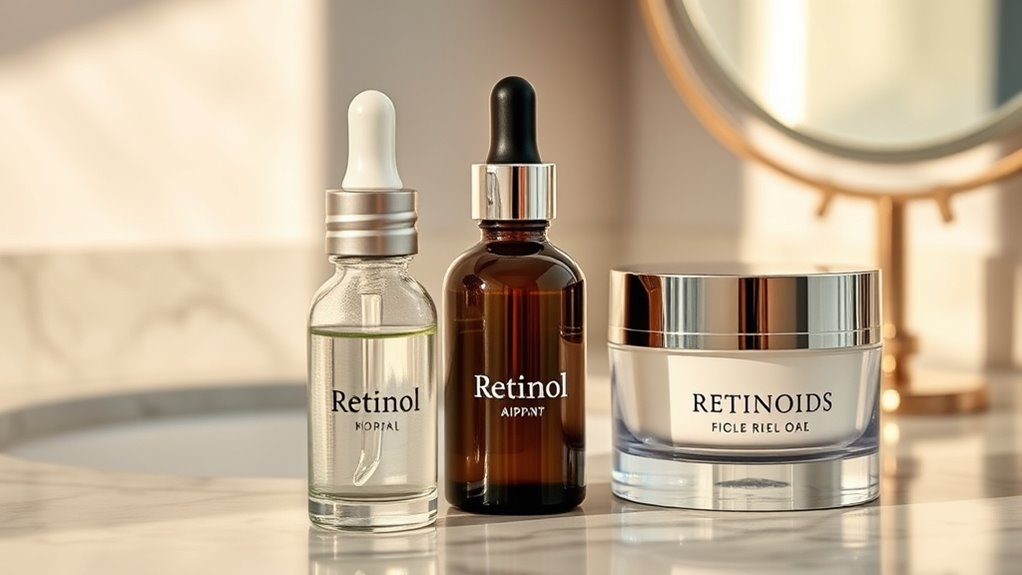
When introducing retinoids into your skincare routine, it’s vital to prioritize gradual adaptation to minimize skin irritation. Start with a low concentration of retinol (around 0.25%) or milder retinoids to see how your skin tolerates them. Gradually increase application frequency from 2-3 times per week as your skin adapts. Remember, retinoids should be used exclusively at night, and always follow with a broad-spectrum sunscreen during the day to avoid photosensitivity. To reduce dryness and irritation, pair retinoids with soothing ingredients like hyaluronic acid or ceramides. Consulting a skincare professional can help you choose the right product potency and concentration based on your skin tolerance. Patience and careful adjustments are key to reaping their anti-aging benefits.
Frequently Asked Questions
Which Is Better for Anti Aging Retinol or Retinoid?
When choosing between retinol and retinoids for anti-aging, consider your skin’s sensitivity and how quickly you want results. Retinoids, like tretinoin, are more potent and work faster, reducing wrinkles and boosting collagen in a shorter time. Retinol is gentler, ideal if you have sensitive skin, but it takes longer to see noticeable improvements. Your choice depends on your skin’s needs and your patience for gradual results.
Is Retinol 1% Stronger Than Retinoid 2%?
You’re wondering if retinol 1% is stronger than a retinoid 2%. Generally, the retinoid 2% is more potent because it contains active ingredients that work directly on your skin’s receptors, delivering faster and more noticeable anti-aging results. Retinol 1% needs enzymatic conversions to become active, making it less immediately effective. So, in most cases, retinoid 2% outperforms retinol 1% in strength and efficacy.
What Is the Rule of 3 for Retinol?
The rule of 3 for retinol guides you to start with a 0.3% concentration, then gradually increase to 0.5%, and finally reach 1%. This approach helps your skin adapt slowly, reducing irritation. You should apply retinol every third night initially and increase frequency over time. Patience is key, as visible results typically appear after 3 to 6 months of consistent use.
What Is More Powerful Than Retinol?
When considering what’s more powerful than retinol, you’re looking at prescription retinoids like tretinoin and tazarotene. These work more directly and intensely on your skin’s receptors, offering quicker, more noticeable anti-aging results. While they’re highly effective, they can also cause more irritation, so it’s wise to seek professional guidance. Synthetic options like adapalene target specific concerns better, making them stronger options for those seeking faster improvements.
Why Are Retinoids the Most Effective Ingredient for Improving the Signs of Skin Aging?
You wonder why retinoids are the most effective for improving skin aging. They activate powerful retinoic acid receptors in your skin, boosting collagen production and speeding up cell turnover. Unlike other ingredients, they target multiple skin layers, enhancing texture, elasticity, and reducing wrinkles, fine lines, and age spots faster. Prescription retinoids like tretinoin have proven results in just months, making them the gold standard for reversing signs of aging effectively.
Conclusion
Choosing between retinol and retinoids is like finding the perfect key to release youthful skin. With understanding and proper use, you can harness their powerful anti-aging effects safely. Remember, patience and consistency are your best friends, like a gardener tending to a delicate bloom. Stick to your routine, listen to your skin, and watch as your complexion transforms, revealing a radiant glow that’s as inspiring as a sunrise after a long night.


